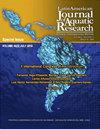A pilot tagging program on southern rays bream (Brama australis): methodology and preliminary recaptures
IF 0.8
4区 农林科学
Q3 FISHERIES
Latin American Journal of Aquatic Research
Pub Date : 2023-02-28
DOI:10.3856/vol51-issue1-fulltext-2950
引用次数: 1
Abstract
The southern rays bream (Brama australis) is a highly migratory, epi-mesopelagic species supporting an important artisanal fishery off central-southern Chile. Despite its importance, several questions exist about this species's demography and migratory routes. The first step in understanding the migratory behavior of B. australis is to test the feasibility of a conventional tagging program, a standard mark-recapture method, to infer migration in fish. Between February 2020 and December 2021, conventional tagging was conducted during 21 fishing trips on board artisanal vessels off Lebu harbor (Biobío Region, Chile) using gillnets, longlines, and handlines. Three thousand nine hundred forty-six individuals of B. australis between 30 and 55 cm fork length were tagged using external T-anchor bar labels (commonly known as "spaghetti"). Approximately 100 and 200 fish were tagged per fishing trip using longlines and gillnets, respectively. The size distribution of the tagged individuals was consistent with those retained in the catch, with 90% of tagged fish being longer than the fork length at 50% maturity. Eight tags have been recovered off the coast of Lebu up to May 2022. With times at liberty between 50 and 537 days. These preliminary recaptures are also analyzed in the context of the conceptual model for demography and migration proposed for this species in Chile. The main conclusion of this research is that a conventional tagging program is feasible for B. australis in Chile.南方鳐(Brama australis)标记试验项目:方法和初步捕获
南鳐(Brama australis)是一种高度洄游的中上层鱼类,支持智利中南部的重要手工渔业。尽管它很重要,但关于该物种的人口结构和迁徙路线,仍存在一些问题。了解澳大利亚B.australis迁徙行为的第一步是测试传统标记程序(一种标准的标记重新捕获方法)的可行性,以推断鱼类的迁徙。在2020年2月至2021年12月期间,在Lebu港(智利比奥比奥地区)附近的手工渔船上进行了21次常规标记,使用刺网、延绳和手柄。使用外部T形锚条标签(通常称为“意大利面条”)标记了叉长在30至55厘米之间的三亿九千四百四十六只澳大利亚B.australis个体。每次捕鱼分别使用延绳钓线和刺网对大约100条鱼和200条鱼进行标记。标记个体的大小分布与捕获物中保留的个体一致,90%的标记鱼在50%成熟时比叉长。截至2022年5月,已在勒布海岸发现8个标签。自由时间在50到537天之间。这些初步的捕获也在智利为该物种提出的人口学和迁徙概念模型的背景下进行了分析。本研究的主要结论是,传统的标记程序在智利是可行的。
本文章由计算机程序翻译,如有差异,请以英文原文为准。
求助全文
约1分钟内获得全文
求助全文
来源期刊

Latin American Journal of Aquatic Research
FISHERIES-MARINE & FRESHWATER BIOLOGY
CiteScore
1.70
自引率
10.00%
发文量
44
审稿时长
4-8 weeks
期刊介绍:
Latin American Journal of Aquatic Research- LAJAR is the continuation of the journal Investigaciones Marinas (1970-2007) and is published since 2008 by the Escuela de Ciencias del Mar, Facultad de Ciencias del Mar y Geografía of the Pontificia Universidad Católica de Valparaíso. LAJAR is an “Open Access” journal that publishes in English language, original research articles, reviews and short communications on aquatic science, which contain the results of research conducted in aquaculture or in oceanic and coastal marine waters of Latin America.
The following topics are considered: Physical Oceanography, Chemical Oceanography, Marine Biogeochemistry, Marine Pollution and Toxicology, Marine Geology and Geophysics, Biological Oceanography, Fisheries and Aquaculture.
 求助内容:
求助内容: 应助结果提醒方式:
应助结果提醒方式:


